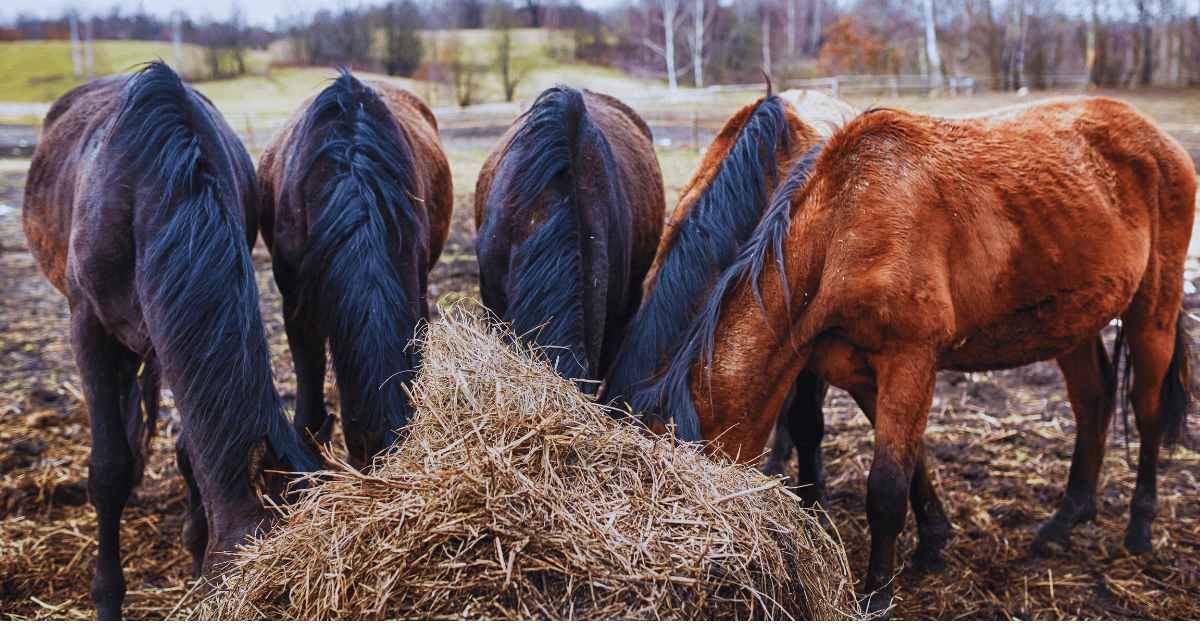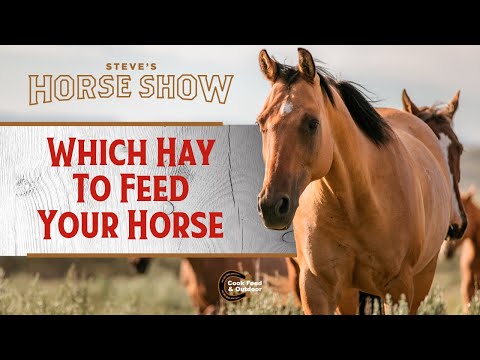Absolutely, horses eat hay, and it’s one of the most crucial parts of their diet. As grazing animals, horses are designed to consume forage throughout the day, and hay provides a convenient, nutritious alternative to fresh pasture, especially during colder months or when grass is scarce. Packed with fiber, hay supports their complex digestive systems and helps keep their gut functioning smoothly.
But not all hay is created equal. The type, quality, and quantity of hay matter greatly. Whether it’s alfalfa, timothy, or grass hay, it needs to be clean, free of mold, and stored properly to ensure it’s safe for consumption.
Overfeeding or offering low-quality hay can lead to issues like colic or respiratory problems. By understanding the role of hay in a horse’s diet, you can ensure they get the nutrients they need while staying healthy and happy.
Understanding Horse Diet
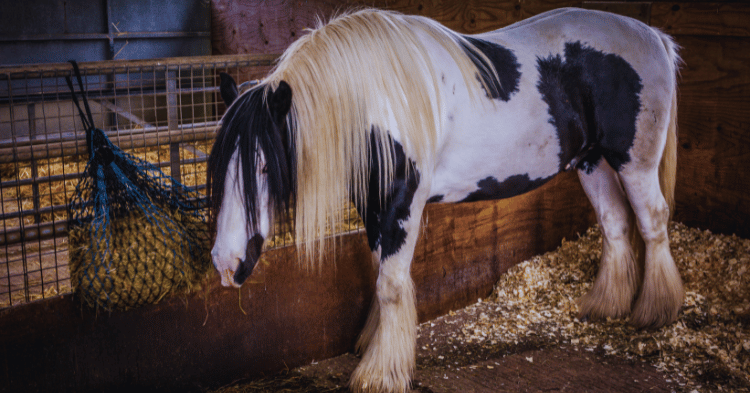
Horses have evolved to have unique dietary needs that ensure their health and longevity. Understanding these needs is essential for anyone who owns or cares for a horse.
Factors Influencing Diet
Horses are natural herbivores and primarily consume grass, hay, and grains. Their digestive system is designed to handle a high-fiber diet, which is essential for their overall health. Several factors influence what a horse should eat:
- Age: Younger horses may require more protein and energy for growth compared to older horses.
- Activity Level: Horses that are more active or used for work may need additional energy.
- Health Conditions: Certain medical conditions may require dietary modifications to ensure the horse receives necessary nutrients without causing harm.
- Availability of Forage: Pastures may not always be available, necessitating the provision of hay.
| Factor | Consideration |
|---|---|
| Age | More protein for young horses |
| Activity Level | Increased energy for active horses |
| Health Conditions | Special dietary needs |
| Forage Availability | Supplementing with hay |
Importance of Routine Feeding
Horses thrive on routine and should be fed small, frequent meals throughout the day. This practice aligns with their natural grazing behavior, where they would typically consume many small meals over a prolonged period. For horses kept in a stable, it’s important to provide two to three feedings per day, ensuring no more than an eight-hour gap between meals.
A consistent feeding routine not only matches their natural eating habits but also helps in maintaining digestive health by keeping a constant stream of saliva, which neutralizes stomach acid.
| Routine | Benefit |
|---|---|
| Small, frequent meals | Aligns with natural grazing |
| 2-3 feedings/day | Prevents long gaps between meals |
| Ongoing hay provision | Promotes saliva production, reducing stomach acid |
For more insights into equine dietary needs, check our articles on do horses eat oats and can horses eat bananas.
By understanding these factors and maintaining a consistent feeding routine, you can help ensure your horse stays healthy and happy.
Hay as Essential Feed
Hay plays a critical role in the diet of horses. It not only provides essential nutrients but also aids in maintaining their digestive health. Let’s explore the differences between hay and pasture, as well as the types of hay available for horses.
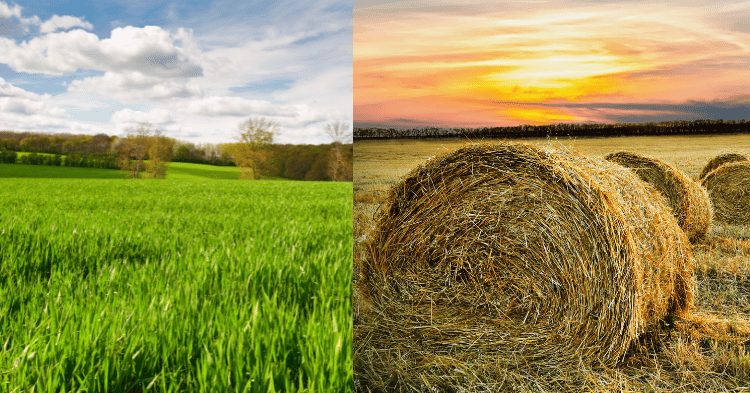
Hay vs. Pasture
Horses are grazing animals by nature, and fresh pasture is often considered the ideal feed for them. Pasture grass is a rich source of essential nutrients, including omega-3 fatty acids, which are important for cellular health and controlling inflammation in horses. However, once grass is converted into hay, omega-3 fatty acids are significantly reduced, potentially leading to an imbalance in the omega-3 to omega-6 ratio in the horse’s diet. This may necessitate supplementation for horses with limited access to fresh pasture (USEventing).
Fresh pasture is also abundant in vitamins A, C, and E. These vitamins play crucial roles in protecting the horse’s body from oxidative stress and supporting overall health. However, the levels of these vitamins diminish once the grass is harvested for hay. Therefore, horses lacking access to fresh pasture may require vitamin supplementation to meet their daily needs.
| Nutrient | Fresh Pasture | Hay |
|---|---|---|
| Omega-3 Fatty Acids | High | Low |
| Vitamin A | High | Reduced |
| Vitamin C | High | Reduced |
| Vitamin E | High | Reduced |
| Crude Protein | Higher quality | Lower quality |
Nutrition data adapted from USEventing and Mad Barn.
Due to these differences, horses relying primarily on hay may need to consume more forage to obtain the same amount of calories as pasture, since hay typically has higher fiber content and lower digestible energy (Mad Barn).
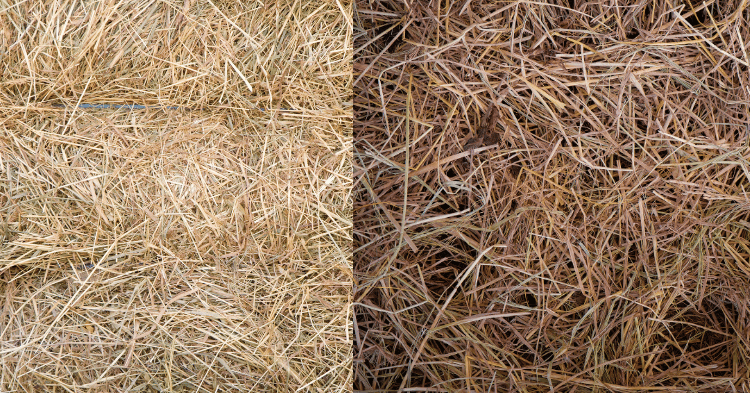
Types of Hay: Grass vs. Legume
When it comes to hay, there are two main types: grass hay and legume hay. Each type offers different nutritional benefits and is suitable for different feeding scenarios.
Grass Hay:
Grass hay includes varieties such as timothy, orchard grass, and Bermuda grass. Grass hay is typically lower in protein and calcium compared to legume hay, making it suitable for horses that require maintenance-level nutrition. It is also higher in fiber, which helps to promote healthy digestion.
Legume Hay:
Legume hay consists of varieties like alfalfa and clover. This type of hay is richer in protein, energy, and calcium compared to grass hay. Thus, it is often recommended for growing horses, lactating mares, and horses in heavy work. However, due to its higher nutrient content, it should be fed in controlled amounts to prevent potential health issues such as obesity or excess calcium intake.
| Type of Hay | Protein (%) | Calcium (%) | Use Case |
|---|---|---|---|
| Grass Hay | 8-12 | 0.3-0.5 | Maintenance, Older Horses |
| Legume Hay | 15-22 | 1.2-2.0 | Growing, Lactating Mares, Performance Horses |
Hay type selection should be based on the specific nutritional needs of your horse. For more in-depth information about horse diets, you may find our articles on can horses eat bananas and can horses eat watermelon useful.
Selecting the right type of hay is essential for maintaining your horse’s health and performance. By understanding the differences between hay and pasture and identifying the most appropriate type of hay for your horse, you can ensure they receive the balanced diet they need.
Nutritional Value of Hay
Hay serves as a cornerstone in the diet of horses, providing essential nutrients required for their well-being. In this section, we review the protein levels, energy, carbohydrates, and the calcium and phosphorus balance in hay.
Protein Levels in Hay
The protein content in hay can vary significantly, depending on its type. Grass hay generally contains lower protein levels, ranging from 8% to 14%. In contrast, legume hay, such as alfalfa, boasts higher protein levels, ranging from 15% to 22%.
| Hay Type | Protein Content (%) |
|---|---|
| Grass Hay | 8% – 14% |
| Legume (Alfalfa) Hay | 15% – 22% |
Protein is crucial for muscle development and overall growth, making it an essential nutrient in a horse’s diet. For more information about feeding habits, you may also want to explore whether do horses eat grass.
Energy and Carbohydrates in Hay
Hay typically has a lower digestible energy compared to pasture due to its higher fiber content. Consequently, horses relying primarily on hay may need to consume more forage to obtain the equivalent amount of calories as they would from pasture, which is generally more digestible (Mad Barn).
The Non-Structural Carbohydrates (NSC), including the sugar and starch content in hay, are absorbed into the bloodstream as glucose. This is an important factor for horses, especially those who are insulin resistant, as they may need to be put on low NSC “low-carb” diets (Sweetwater Nutrition).
Calcium and Phosphorus Balance
The balance between calcium and phosphorus is critical in a horse’s diet, with the ideal ratio ranging from 3:1 to 1:1. Horses need at least as much calcium as phosphorus in their diets (Sweetwater Nutrition). This balance helps in maintaining healthy bone structure and supporting overall metabolic functions.
For more insights on unique dietary questions, feel free to explore articles such as can horses eat apples and can horses eat watermelons.
By understanding the nutritional value of hay, horse owners can make informed decisions about their feeding practices, ensuring their horses enjoy a balanced and healthy diet.
Quality and Selection
The Impact of Hay Quality
The quality of hay significantly impacts a horse’s health, well-being, and performance because hay constitutes a large portion of their diet. Hay quality can be influenced by various factors such as harvesting, wrapping, storage conditions, and age (Equigroomer). High-quality hay contains essential nutrients and minimizes the risk of deficiencies.
Feeding older or poorly stored hay can lead to deficiencies in vital nutrients like Vitamins A and E, biotin, silicon, zinc, and copper, which may necessitate additional dietary supplements (Equigroomer). This makes it crucial to provide high-quality, well-maintained hay to support a horse’s best health.
Second Cut vs. First Cut Hay
There are notable differences between first and second cut hay that can affect a horse’s dietary quality. First cut hay is typically more stemmy and has lower nutrient density. It is often coarser and less leafy compared to second cut hay. Second cut hay, in contrast, is generally softer, leafier, and richer in nutrients, making it more palatable for horses (Sweetwater Nutrition).
| Hay Type | Texture | Nutrient Density | Other Characteristics |
|---|---|---|---|
| First Cut | Stemmy | Lower | Coarser, Less Leafy |
| Second Cut | Softer | Higher | Leafier, More Palatable |
Due to these differences, many horse owners opt for second cut hay, especially for horses with higher nutritional requirements. However, the choice between first and second cut hay should be based on the individual needs of the horse and the availability of hay types in the area. For more about the feeding habits of horses, visit our articles on do horses eat oats and do horses eat bananas.
Quality hay selection is essential for meeting the specific dietary needs of horses, ensuring they receive the necessary nutrients to thrive. For additional insights on horse diet management, check our page on do horses eat hay.

